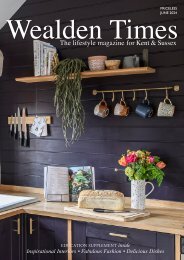Wealden Times | WT264 | May 2024 | Love Your Home Supplement inside
The lifestyle magazine for Kent & Sussex - Inspirational Interiors, Fabulous Fashion, Delicious Dishes
The lifestyle magazine for Kent & Sussex - Inspirational Interiors, Fabulous Fashion, Delicious Dishes
You also want an ePaper? Increase the reach of your titles
YUMPU automatically turns print PDFs into web optimized ePapers that Google loves.
Garden<br />
I<br />
spend a lot of my time adding<br />
structure to gardens – trees, shrubs,<br />
evergreens and architectural foliage<br />
plants. We need these to give our borders<br />
cohesion and good overall shape, to act<br />
as backdrops and frames for the seasonal<br />
plants as they come and go. Structure<br />
is sensible and important, but without<br />
colour there’s not much joy – it can seem<br />
like an empty stage waiting for the action.<br />
It could be a floaty, soothing blend of<br />
harmonious pastels or a riotous clash of<br />
the most vibrant and cheerful hues – taste<br />
is personal and often idiosyncratic, but<br />
whatever side of the colour wheel you<br />
roll on, adding a splash (or a flood) of<br />
colour will instantly bring a garden to life.<br />
Some effects of colour –<br />
and colour schemes<br />
Pale colours recede and make things seem<br />
larger or further away. Strong colours are<br />
dominant and rush towards us. You can<br />
use this to create illusions with space or<br />
to play with perspective – make an area<br />
seem bigger by using paler plants in the<br />
background and brights and darks closer<br />
in. Dense, dark colours are sombre, but<br />
can provide an anchor point, and make<br />
excellent backdrops for other plants.<br />
Pale colours will lift a shady area (as will<br />
glossy foliage – it is reflective). Fiery reds<br />
and oranges create excitement, whereas<br />
pastel colours are calming. The quality of<br />
light changes during the day too – whites,<br />
pale creams, mauves and blues shine out<br />
at dawn and dusk and are ‘washed out’<br />
in strong light, whereas bright colours<br />
look best in full sun and fade into the<br />
background as the sun goes down.<br />
It’s easy to forget that green is a colour<br />
too. In the garden it becomes a calming<br />
neutral background, because there’s<br />
so much of it around, but its effects<br />
are felt nevertheless. Green falls in the<br />
middle of the spectrum and is restful<br />
to look at – it is the colour of nature<br />
and immediately makes us more relaxed<br />
(this is why so many hospital walls<br />
are painted in soft greens and blues).<br />
Whether it’s the darkest shade of holly<br />
through acid lime, chartreuse, glaucous,<br />
almost blue to pale and silvery, green<br />
remains a tranquil foil, harmonising<br />
with other shades of green and providing<br />
a buffer between patches of colour.<br />
Harmonies are created by using<br />
similar colours – pale pastel shades<br />
of mauve, blue and pink blend well<br />
Dahlia ‘Nicholas’<br />
Rudbeckia ‘Goldsturm’<br />
Ranunculous grown in a pot<br />
together and look lovely in semi-shade<br />
or the dappled light under trees. Cottage<br />
garden perennials like Nepeta (catmint),<br />
Geranium ‘Johnsons Blue’, or the<br />
longer flowering, but less interesting to<br />
pollinators, G. ‘Rozanne’ look romantic<br />
under roses. Sunny borders may need<br />
to be brighter to stand up to harsh<br />
sunlight. Geranium ‘Ann Folkhard’ has<br />
magenta flowers with a dark central ‘eye’,<br />
Geum like the sun (but also damp soil)<br />
and are available in cheerful shades of<br />
orange and yellow – my favourite (at<br />
the moment`) is G. ‘Totally Tangerine’,<br />
which seems to manage and even clump<br />
up unusually well in free draining<br />
conditions. For a splash of vibrant red<br />
you can’t do much better than tall and<br />
architectural Crocosmia ‘Lucifer’, which<br />
enlivens both exotic and cottage schemes.<br />
Fabulous Foliage<br />
The range of flower colours available<br />
to us is mind-blowing, but flowers are<br />
fleeting and can’t be used to carry a<br />
scheme through every month of the year.<br />
Foliage can offer nearly as much variety<br />
in terms of colour – and for a much<br />
longer period. Leafy plants can have the<br />
added advantage of good shape and form<br />
too. Foliage can still be a part of colour<br />
schemes – picking up the colours and<br />
Mix it<br />
up<br />
Jo Arnell<br />
celebrates the joys<br />
of myriad colours<br />
in the garden<br />
Pink cosmos<br />
enhancing their effect, or even to carry<br />
the scheme once the flowers have finished.<br />
A leaf can often have as much colour as<br />
a flower, and is far longer lasting. Large<br />
leaves and architectural foliage will also<br />
bring structure and unity to the border.<br />
Cotinus coggygria (the ‘smoke’ bush – so<br />
called because its flowery plumes look<br />
puffs of smoke) is a large shrub grown<br />
mainly for its leaves. The best known<br />
varieties are ‘Royal Purple’ which has<br />
deep plum coloured foliage, or ‘Grace’<br />
whose leaves are more translucent<br />
and ethereal. Plant Cotinus in a sunny<br />
position at the back, or as a specimen<br />
– the sunshine will make the vibrant<br />
red of the autumn colour stronger.<br />
Berberis is smaller leaved and spiny,<br />
with orange flowers in spring, but<br />
offers similar deep red/bronze and<br />
the deciduous varieties will be fiery in<br />
autumn. It’s a big group – a Berberis<br />
could be a huge back of the border<br />
monster, a diminutive dwarf like B.<br />
‘Nana’, or even columnar – B. ‘Helmond<br />
Pillar, ‘Orange’ or ‘Golden Rocket’.<br />
Try the exotic looking Melianthus<br />
major, with glaucous, serrated leaves<br />
(it will be cut down by the frosts as it<br />
is slightly tender, but perks up again<br />
in the spring). Euphorbia ‘Wulfenii’<br />
also has glaucous blue/green leaves, <br />
109<br />
priceless-magazines.com

















